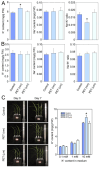Polyethylene terephthalate nanoplastics affect potassium accumulation in foxtail millet (Setaria italica) seedlings
- PMID: 39725935
- PMCID: PMC11670363
- DOI: 10.1186/s12870-024-06007-2
Polyethylene terephthalate nanoplastics affect potassium accumulation in foxtail millet (Setaria italica) seedlings
Abstract
Background: As modern industrial activities have advanced, the prevalence of microplastics and nanoplastics in the environment has increased, thereby impacting plant growth. Potassium is one of the most crucial nutrient cations for plant biology. Understanding how polyethylene terephthalate (PET) treatment affects potassium uptake will deepen our understanding of plant response mechanisms to plastic pollution.
Results: In this study, we examined the impact of PET micro- and nanoplastics on foxtail millet seedling growth and potassium accumulation. Additionally, we measured reactive oxygen species (ROS) production, antioxidant enzyme activities, and the expression levels of the corresponding enzyme-encoding genes. Our findings indicated that the germination and seedling growth of foxtail millet were not significantly affected by exposure to PET plastics. However, the ROS levels in foxtail millet increased under these conditions. This increase in ROS led to the upregulation of several genes involved in K+ uptake and transport (SiHAK1, SiHAK2, SiAKT2/3, SiHKT2;2, SiHKT1;1, SiGORK, and SiSKOR), thereby increasing K+ accumulation in foxtail millet leaves. Further research revealed that higher K+ concentrations in plant leaves were correlated with increased expression of the antioxidant-related genes SiCAT1, SiPOD1, and SiSOD3, as well as increased activities of the corresponding antioxidant enzymes. This response helps mitigate the excessive accumulation and damage caused by ROS in plant cells after PET nanoplastic treatment, suggesting a potential stress response mechanism in foxtail millet against nanoplastic pollution.
Conclusions: Our research indicates that PET nanoplastic treatment induces the expression of genes related to K+ uptake in foxtail millet through ROS signaling, leading to increased K+ accumulation in the leaves. This process mitigates the ROS damage caused by PET nanoplastic treatment by increasing the expression and activity of genes encoding antioxidant enzymes. The present research has unveiled the K+ accumulation-related response mechanism of foxtail millet to PET nanoplastic treatment, contributing significantly to our understanding of both the potassium absorption regulation mechanism in plants and the broader impact of plastic pollution on agricultural crops. This discovery not only highlights the complexity of plant responses to environmental stressors but also underscores the importance of considering such responses when evaluating the ecological and agricultural implications of plastic pollution.
Keywords: Setaria italica; PET nanoplastics; Potassium; ROS.
© 2024. The Author(s).
Conflict of interest statement
Declarations. Ethics approval and consent to participate: Not applicable. Consent for publication: Not applicable. Competing interests: The authors declare no competing interests.
Figures








Similar articles
-
Transcriptome Analysis Reveals the Role of Trehalose in Response to Polyethylene Terephthalate Nanoplastics Treatment in Foxtail Millet (Setaria italica) Seedlings.Food Sci Nutr. 2025 Jul 21;13(7):e70593. doi: 10.1002/fsn3.70593. eCollection 2025 Jul. Food Sci Nutr. 2025. PMID: 40697707 Free PMC article.
-
Sulfur dioxide derivatives alleviate cadmium toxicity by enhancing antioxidant defence and reducing Cd2+ uptake and translocation in foxtail millet seedlings.Ecotoxicol Environ Saf. 2018 Aug 15;157:207-215. doi: 10.1016/j.ecoenv.2018.03.084. Epub 2018 Apr 3. Ecotoxicol Environ Saf. 2018. PMID: 29625394
-
Genome-wide analysis and identification of the low potassium stress responsive gene SiMYB3 in foxtail millet (Setariaitalica L.).BMC Genomics. 2019 Feb 15;20(1):136. doi: 10.1186/s12864-019-5519-2. BMC Genomics. 2019. PMID: 30767761 Free PMC article.
-
Foxtail millet research in supporting climate change resilience efforts: Bibliometric analysis and focused literature review.Heliyon. 2025 Jan 28;11(3):e42348. doi: 10.1016/j.heliyon.2025.e42348. eCollection 2025 Feb 15. Heliyon. 2025. PMID: 39968133 Free PMC article. Review.
-
Exploring omics solutions to reduce micro/nanoplastic toxicity in plants: A comprehensive overview.Sci Total Environ. 2025 Apr 25;974:179220. doi: 10.1016/j.scitotenv.2025.179220. Epub 2025 Mar 26. Sci Total Environ. 2025. PMID: 40147233 Review.
Cited by
-
Transcriptome Analysis Reveals the Role of Trehalose in Response to Polyethylene Terephthalate Nanoplastics Treatment in Foxtail Millet (Setaria italica) Seedlings.Food Sci Nutr. 2025 Jul 21;13(7):e70593. doi: 10.1002/fsn3.70593. eCollection 2025 Jul. Food Sci Nutr. 2025. PMID: 40697707 Free PMC article.
References
-
- Zou Z, Li S, Wu J, Guo S, Zhang Y, Huang M, et al. Effects of nanopolystyrene addition on nitrogen fertilizer fate, gaseous loss of N from the soil, and soil microbial community composition. J Hazard Mater. 2022;438:129509. - PubMed
-
- Banerjee A, Shelver WL. Micro- and nanoplastic induced cellular toxicity in mammals: a review. Sci Total Environ. 2021;755:142518. - PubMed
-
- Andrady AL. The plastic in microplastics: a review. Mar Pollut Bull. 2017;119:12–22. - PubMed
-
- Peng G, Xu P, Zhu B, Bai M, Li D. Microplastics in freshwater river sediments in Shanghai, China: a case study of risk assessment in mega-cities. Environ Pollut. 2018;234:448–56. - PubMed
MeSH terms
Substances
Grants and funding
- 2021BQ40/The Doctoral Research project of Shanxi Agricultural University
- 202204051001019/The Science and Technology Innovation Young Talent Team of Shanxi Province
- 202204051001019/The Science and Technology Innovation Young Talent Team of Shanxi Province
- 20230003/Fund Program for the Scientific Activities of Selected Returned Overseas Professionals in Shanxi Province
- 32272012/National Natural Science Foundation of China
LinkOut - more resources
Full Text Sources
Medical
Research Materials

